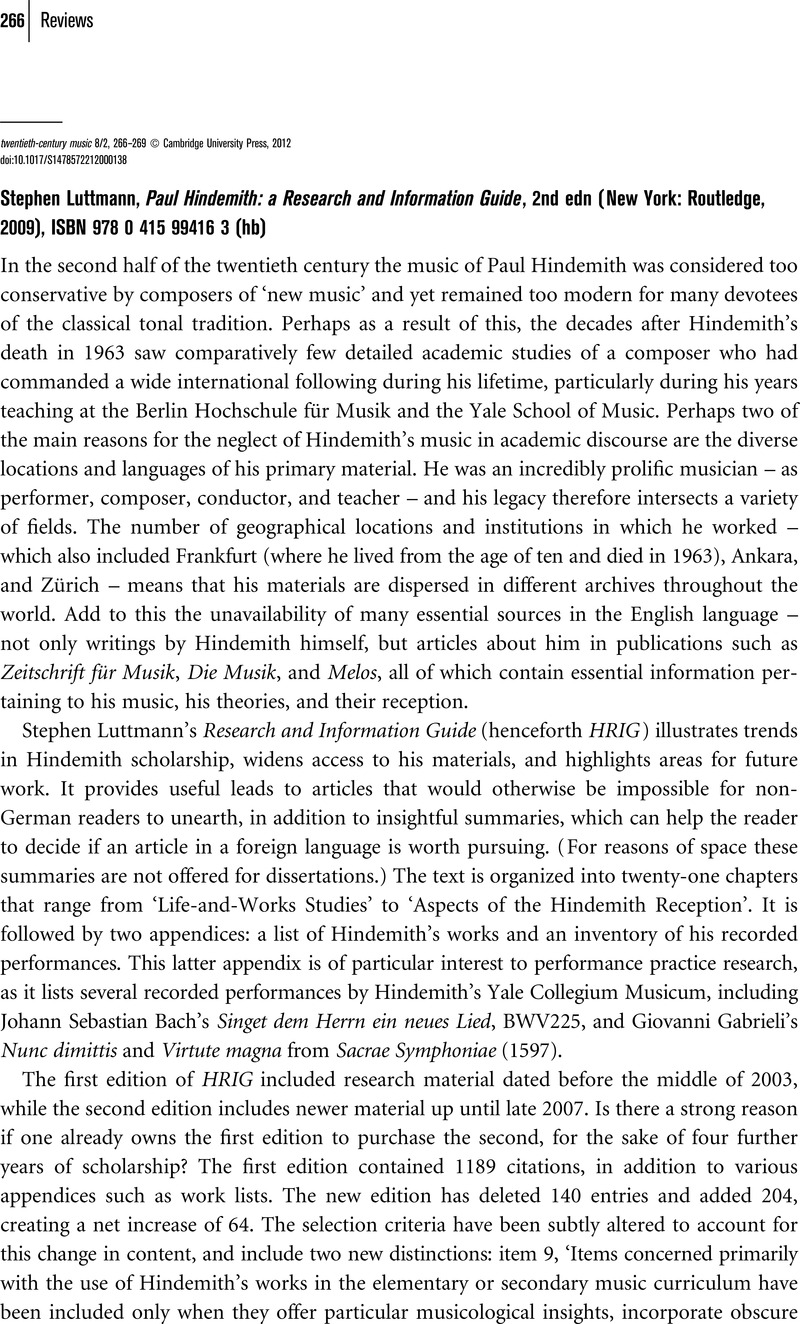No CrossRef data available.
Article contents
Stephen Luttmann, Paul Hindemith: a Research and Information Guide, 2nd edn (New York: Routledge, 2009), ISBN 978 0 415 99416 3 (hb)
Published online by Cambridge University Press: 31 July 2012
Abstract

- Type
- Reviews
- Information
- Copyright
- Copyright © Cambridge University Press 2012
References
1 Joel Haney, ‘The Emergence of a Postwar Musical Outlook: Hindemith's Hard-Edged Simplicity, 1919–1922’ (PhD diss., Yale University, 2006); Jörg Hindemith official website <http://www.joerghindemith.de>.
2 Schubert, Giselher, ‘Hindemiths Briefe an Karin Thienemann 1932–1937’, Hindemith-Jarbuch 36 (Frankfurt: Schott, 2007), 146–86Google Scholar.
3 Forte, Allen, Contemporary Tone Structures (New York: Teacher's College, Columbia University, 1955)Google Scholar.
4 Forte, , The Structure of Atonal Music (New Haven: Yale University Press, 1973)Google Scholar. David Neumeyer, ‘Counterpoint and Pitch Structure in the Early Music of Paul Hindemith’ (PhD diss., Yale University, 1976); see also Neumeyer, , The Music of Paul Hindemith (New Haven, CT: Yale University Press, 1987)Google Scholar.
5 Hinton, Stephen, review of David Neumeyer, The Music of Paul Hindemith, Music Analysis 7/3 (1988), 356–9CrossRefGoogle Scholar.
6 Bobbitt, Richard, ‘Hindemith's Twelve-Tone Scale’, Music Review 26/2 (1965), 104–17Google Scholar.
7 Hindemith, Paul, The Craft of Musical Composition (Mainz: Schott, 1942), 56Google Scholar.
8 Typographical errors in the print edition include a misdirection of the reader on page 542 to Virgil Thomson in item 438 (which is actually by Dietmar Schenk), and font errors in the spelling of Czech names.
9 Trippett, David, ‘Composing Time: Zeno's Arrow, Hindemith's Erinnerung, and Satie's Instantanéisme’, Journal of Musicology 24 (2007), 522–80CrossRefGoogle Scholar; Haney, Joel, ‘Slaying the Wagnerian Monster: Hindemith, Das Nusch-Nuschi, and Music Germanness after the Great War’, Journal of Musicology 25 (2008), 339–93CrossRefGoogle Scholar; Guerrero, Jeannie, ‘The Presence of Hindemith in Nono's Sketches: a New Context for Nono's Music’, Journal of Musicology 26 (2009), 481–511CrossRefGoogle Scholar.
10 Walden, Daniel K. S., ‘Noting Images: Understanding the Illustrated Manuscripts of Mendelssohn's Schilflied and Hindemith's Ludus Tonalis’, Music Theory Online 16/3 (2010) <http://www.mtosmt.org/issues/mto.10.16.3/mto.10.16.3.walden.html>Google Scholar; O'Connell, Kevin, ‘Hindemith's Voices’, Musical Times 152/1915 (2011), 3–18Google Scholar.
11 Breivik, Magnus, Musical Functionalism (Hillsdale, NY: Pendragon Press, 2012)Google Scholar; Sutherland, Ian and DeNora, Tia, ‘Musical Creativity as Social Agency: Composer Paul Hindemith’, in Musical Imaginations: Multidisciplinary Perspectives on Creativity, Performance, and Perception, ed. Hargreaves, David, Miell, Dorothy, and MacDonald, Raymond (Oxford: Oxford University Press, 2012), 73–86Google Scholar. Breivik's doctoral dissertation (1999), which formed the platform for his monograph, is cited as item 309.
12 Paul Hindemith Stiftung <www.paul-hindemith.org>; Schubert, Giselher, ‘Hindemith, Paul’, in The New Grove Dictionary of Music and Musicians, 2nd edn, ed. Sadie, Stanley and Tyrrell, John (London: Macmillan, 2001), vol. 11, pp. 523–38Google Scholar; online at Oxford Music Online <www.oxfordmusiconline.com>.




